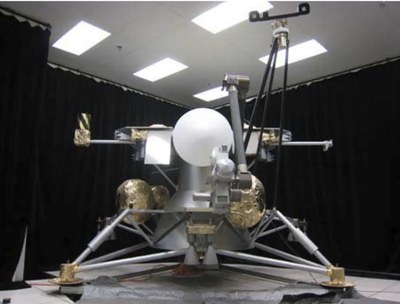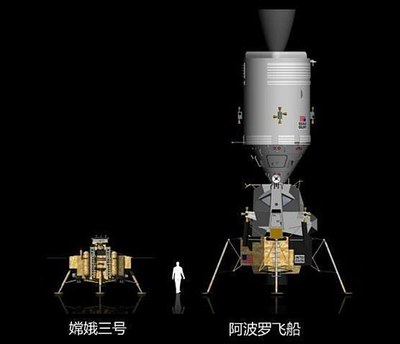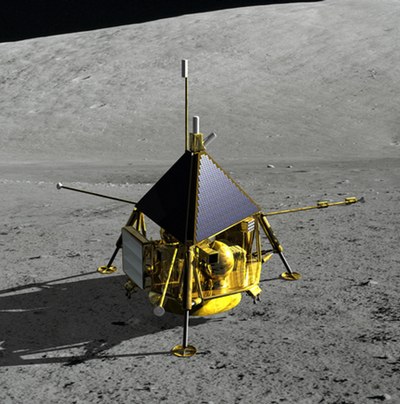Red Moon, Blue Moonby Dwayne Day
|
| In the 2011 decadal survey two of the seven potential missions were lunar missions, demonstrating the high priority the scientific community still places upon lunar science. |
NASA divides its planetary missions into three classes: flagship (large), New Frontiers (medium), and Discovery (small). The agency uses the planetary science decadal survey to select science goals for the first two categories. But NASA can also fly robotic missions in support of its human space exploration goals, and those missions are chosen by agency officials based upon their perceived requirements. In the past decade, the agency has flown lunar science missions to support the goals of President Bush’s Vision for Space Exploration, specifically the goal of sending humans to the Moon. Although the Vision for Space Exploration no longer guides NASA policy, some aspects of that previous policy continue to influence current NASA studies and plans.
Grabbing some magic stones
The last planetary science decadal survey was produced in 2011, establishing planetary science goals for 2013–2022. It ranked several flagship-class missions, none of them lunar missions. Flagship-class missions—Cassini is one example—are supposed to produce expansive science returns, and because the Moon has already been studied in great detail it is difficult to conceive of a flagship-class robotic lunar mission. However, the decadal survey also selects a set of medium-sized New Frontiers class missions, and in the 2011 decadal survey two of the seven potential missions were lunar missions, demonstrating the high priority the scientific community still places upon lunar science. About twice each decade NASA holds a New Frontiers competition where teams can compete based upon science, technical maturity, and ability to stay within the program’s cost cap, which the decadal survey recommended should be $1 billion in fiscal year 2015 dollars (plus launch vehicle.) As a result, a team proposing a Venus landing mission could compete against a team proposing a comet sample return mission and another proposing a lunar landing mission—despite the high ranking of lunar science, NASA officials use competition to choose the best missions.
There are currently two New Frontiers missions flying: New Horizons heading toward Pluto, and Juno heading toward Jupiter, both scheduled for arrival in 2015. An asteroid sample return mission named OSIRIS-REx is also in development. The next New Frontiers competition (NF4) will probably take place starting in 2016, with NF5 following in 2021.
Five possible missions can compete for NF4: comet sample return, Venus in-situ explorer, Saturn probe, Trojan tour, and a lunar South Pole-Aitken Basin sample return. When one of these possible missions is selected, it is then removed from the list for the following competition.
The Moon’s South Pole-Aitken Basin is the remnant of a massive ancient lunar impact, with a diameter of 2,500 kilometers and a depth of 13 kilometers, and derives its name from the fact that it stretches from the lunar South Pole to the Aitken crater. Remote sensing from orbiters shows that its composition is different than the Apollo landing sites on the near side of the Moon. This is because the impact mixed material from the lunar surface and deep in the Moon’s interior, which could potentially provide the first sample of this material to researchers interested in the interior composition of the Moon.
The 2011 decadal survey stated that the goals of a sample return mission to the South Pole-Aitken Basin were:
- Determine the chronology of basin-forming impacts and constrain the period of late heavy bombardment in the inner solar system and thus address fundamental questions of inner solar system impact processes and chronology;
- Elucidate the nature of the Moon’s lower crust and mantle by direct measurements of its composition and of sample ages;
- Characterize a large lunar impact basin through “ground truth” validation of global, regional, and local remotely sensed data of the sampled site;
- Elucidate the sources of thorium and other heat-producing elements in order to understand lunar differentiation and thermal evolution; and
- Determine ages and compositions of farside basalts to determine how mantle source regions on the far side of the Moon differ from regions sampled by Apollo and Luna.
A lander would set down on the Moon, sift the soil to collect pebbles of a size that would provide data on the major scientific questions, and put them in a sample return container. The container would be launched off the Moon’s surface and back to Earth. Although NASA landed the Surveyor spacecraft on the Moon in the 1960s, and the Soviet Union conducted sample return missions in the 1970s, this mission would be more difficult for a couple of reasons. One is that the landing would take place on the far side of the Moon, requiring some kind of communications relay back to Earth. In addition, the sample return requirement is greater for a far side site than it was when the Soviet Union returned small amounts of lunar material from the near side.
During previous New Frontiers competitions, teams proposed sample return missions that were not selected. But one byproduct of NASA’s competitive science missions is that losing teams can learn how to improve their proposals for the next competition. In the last round, lunar scientist Brad Jolliff and a team that included engineers from JPL and other institutions proposed the MoonRise lander. JPL conducted extensive engineering tests to demonstrate the sampling mechanism. When the New Frontiers competition is held again, possibly in 2016, MoonRise or a similar proposal will probably be a stronger contender.
 A model of the MoonRise lander, proposed but not selected in the last round of the New Frontiers competition. (credit: JPL) |
Listening for the echoes
For New Frontiers 5, which will probably be competed in 2021 or 2022, two additional missions will be added to the competition: an Io explorer that would study the volcanism on Jupiter’s hellish moon Io, and a Lunar Geophysical Network.
| If a sample return mission is selected for New Frontiers, it would likely not be launched until around 2021. If a Lunar Geophysical Network is selected early in the next decade, its small lunar landers would not set down on the Moon until later in the 2020s. |
Several Apollo missions placed seismic sensors on the Moon’s surface. They were shut down decades ago due to budget cuts, but not before they returned some intriguing data about the interior of the Moon. By measuring seismic disturbances at multiple locations, scientists can essentially “see” through the Moon. But one of the primary limitations of the Apollo seismic network was that the sensors were all on the near side of the Moon. If you draw lines through the Moon’s interior connecting the sensors, the lines are all relatively shallow, meaning that they did not provide a good look deep into the interior, especially near the center of the Moon. The Lunar Geophysical Network would involve placing three or more sensors at various locations on the Moon, including the far side, thus making it possible to see deep into the Moon and gather much data about its interior and its formation. In addition, today’s seismic sensors are far superior to the ones during Apollo, and produce more data—the equivalent of broadband compared to a 2400-baud telephone modem.
A multi-lander mission means greater costs than a single lander. Several landers would have to be stacked on a single rocket in a limited volume. They would have to land separately at far-spaced locations on the Moon. And at least one of them would have to set down on the hidden far side. Add to that a requirement to communicate with the far side lander via some kind of relay and the mission can get expensive. The Moon also has a two-week-long night and the seismic sensors would have to operate during this period. One method to accomplish this is with expensive radioisotope thermoelectric generators (RTGs), essentially atomic batteries. Another method is to carry heavy batteries that are recharged by solar panels during the daytime.
Alan Stern, the principal investigator for the New Horizons Pluto spacecraft, served as NASA’s Associate Administrator for Space Science from 2007 to 2008. During that period Stern advocated an International Lunar Network. In Stern’s view, NASA would fund at least two landers, called the “anchor nodes,” and a foreign partner such as Russia or India, with their own lunar lander plans, could carry along a seismic sensor as well, thus spreading out the cost of gathering seismic data. Stern viewed this as a strategically directed mission that was essentially an extension of the Constellation program’s lunar exploration goals, although the mission was primarily scientific. Although the plan died when Stern left, such a network remains a possibility for the future, especially as both India and Russia continue to be interested in lunar landers.
If a sample return mission is selected for New Frontiers, it would likely not be launched until around 2021. If a Lunar Geophysical Network is selected early in the next decade, its small lunar landers would not set down on the Moon until later in the 2020s. It is also possible for teams to propose lunar lander missions for NASA’s Discovery competitions. Reportedly, during the last Discovery competition at least one of the 28 proposals was for a lunar seismic lander. This proposal was not selected, but it could compete again. Other scientists have ideas for lunar rovers to explore the lunar surface, and scientists at Ames Research Laboratory believe that their LADEE spacecraft could form the basis for a small lander. However, NASA’s planetary science budget has been cut in recent years and the Discovery budget has taken the brunt of the reductions, meaning that the next Discovery selection is being delayed. The chances of a NASA science mission landing on the Moon by the end of this decade appear slim.
Looking for gold (or at least water)
When President Bush announced the Vision for Space Exploration in 2004, one of the primary goals was returning humans to the Moon. NASA spaceflight experts quickly determined that in order to accomplish this they required high-resolution images of potential lunar landing sites. They then developed the Lunar Reconnaissance Orbiter, which launched in 2009 and continues to orbit the Moon today. LRO carries a powerful camera, but the scientific community also provided several instruments in a serendipitous merging of human exploration and science. NASA also created a lunar exploration program to produce additional robotic spacecraft to support human exploration goals. The Lunar Atmosphere and Dust Environment Explorer (LADEE) was developed as part of this effort.
| At the LEAG meeting, a person speaking about the Resource Prospectormission explained that NASA was funding a launch vehicle and the RESOLVE instrument package, but not a lander or a rover. |
One last remnant of the previous efforts was the Resource Prospector and its miniature chemistry and drilling plant known as RESOLVE. Resource Prospector has somehow managed to linger on despite President Obama forcefully declaring a lack of interest in sending humans to the Moon. The mission would involve a lander and rover intended to set down near the Moon’s south pole. The rover, about the size of the Spirit and Opportunity Mars rovers, would venture out onto the surface to gather information on volatiles potentially in and underneath the lunar regolith. That information would be used to guide future decisions about the possibility of mining the Moon for water for use in future lunar exploration.
Resource Prospector’s status is murky. During a recent meeting of the Lunar Exploration Analysis Group (LEAG), which serves a pseudo-advisory function for NASA, a person speaking about the mission explained that NASA was funding a launch vehicle and the RESOLVE instrument package, but not a lander or a rover. Canada is apparently interested in building the rover, but many attendees were confused about how the rover would get to the lunar surface considering that there is no lander funded, and it is not really possible for Canada to commit to funding a rover until this major detail is worked out. With the NASA budget outlook unclear as a result of larger federal funding issues, LEAG attendees were also confused about how serious any NASA commitment to fund a launch vehicle in future years is, especially considering the uncertainty over what it would actually launch.
 A Chinese illustration of their Chang’e-3 lander at the same scale as the Apollo spacecraft; a hint of the country”s long-term ambitions? |
Other trips to the Moon
In addition to the NASA missions, there is the possibility of a private lunar lander in the next decade. The Google Lunar X PRIZE has been underway since 2007. Initially over a dozen teams announced plans to compete for it, but the number has dwindled over the years, and it is unclear if any of them have the money required to actually mount such a mission (see “As China goes to the Moon, prize teams stay in the race”, The Space Review, December 2, 2013.) The remaining competitors talk about being close to gaining sufficient funding, but there is no way to know if that is true, and at least one of the competitors has implied that they would like to obtain NASA funding to build the lander for the Resource Prospector mission.
Meanwhile, both Russia and India continue to indicate that they are interested in sending landers to the Moon. The Russian plans are complex and impressive, and also unlikely. India, which recently sent a small spacecraft to Mars, is a more probable contender. But India’s lunar plans have suffered some setbacks, and the country’s space program has been scaled back from the ambitious goals set only a few years ago.
China is the one nation that looks like it has strong lunar aspirations and the intent and funding to achieve them. Chang’e-3 has a backup spacecraft that will probably fly to another location, assuming that its predecessor succeeds. The two rover missions will then be followed by at least one, and possibly two sample return missions. China’s sample return plans include lunar orbit rendezvous with a return stage, a key technology for eventual human lunar missions. If China chooses to attempt sample return from the South Pole-Aitken Basin, they could even achieve American science goals. Maybe they might even share what they learn.
In addition to the scientific goals, there is definitely a political aspect to China’s lunar exploration activities. The landing is highly symbolic, demonstrating a sophisticated technological capability. China’s lunar plans also make the country a more attractive potential partner for international cooperation, offering opportunities available nowhere else. Right now China’s plans are robotic only, but they provide substantial technological capability that could enable China to pursue a human lunar mission if they decide to do so.
